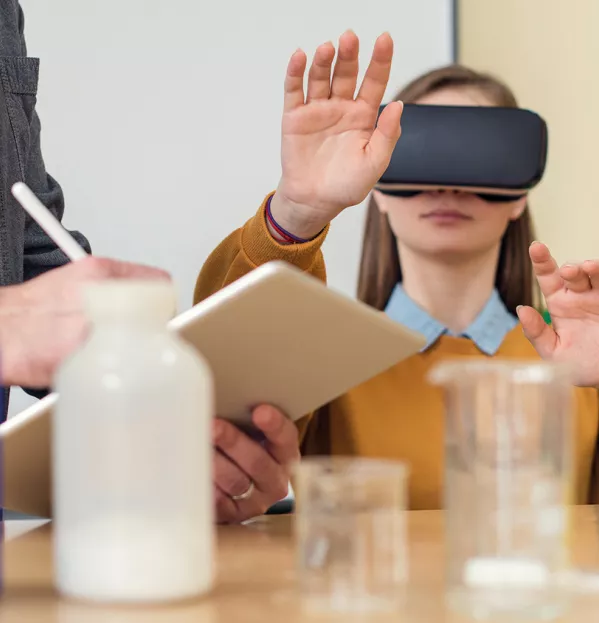‘E-champions’ can save the day

Pupils at Kelvinside Academy have learned about volcanoes from a geologist who was standing on the edge of one, which fumed and bubbled in the background, and have chatted to astronauts in space. They have also used virtual reality to take trips under the sea and to stroll the streets of Rome.
For the Glasgow independent’s head of e-learning Joanna Maclean, however, while these experiences have a place, they are not the reason why Scottish schools need to embrace the digital age. Virtual reality, in particular, has a way to go, she believes - given that it makes some pupils feel sick.
Both the junior and senior school were among the first to be awarded Digital School status since the Scotland-wide scheme, which recognises excellence in digital learning and teaching, was introduced in 2016. And Kelvinside was asked to showcase its work at this year’s Learning Through Technology conference in Edinburgh earlier this month.
Maclean says the school’s virtual learning environment is the centrepiece of its enthusiasm for all things digital. She compares this to Glow - the national digital network for Scottish schools - in sophistication and ambition, and feels that this is where the potential of digital learning can truly be exploited.
Teachers at Kelvinside use the virtual learning environment to share resources with pupils and each other, set homework, create discussion forums and get feedback on their lessons. Now pupils can undertake subjects such as Higher music more independently, working through online resources and uploading videos and audio of them playing for their teachers to comment on.
Videos fast-forward learning
Maclean stresses that she does not think of digital technology as a “silver bullet”, and she has concerns about the lure of screen time and the hours teenagers lose on social media. However, she says that the potential of technology to enhance learning was brought home to her by a colleague who uploaded a video introducing Pythagoras’ theorem, and discovered that on average her pupils watched it 17 times.
Maclean, who has been head of e-learning for six years but began her career as a primary teacher, says: “She realised that if she had been delivering that in the classroom she might have delivered the introduction to the topic a second time with a group needing support, but she wouldn’t have gone over it a third time. Yet, looking at the evidence, they accessed it 17 times - that brought home to me the power of video.”
She also sees the huge potential for pupils to be creative instead of just passively receiving knowledge, which they then regurgitate. A recent knights and castles project involved primary pupils creating and filming battle scenes. And in modern studies, secondary pupils recently created Facebook pages for former US president John F Kennedy and prime minister Theresa May.
“Previously they would not have been able to make a video or to share it and have thousands of people watch it,” Maclean says.
The school is also considering replacing traditional report cards with online profiles for pupils so that parents can see what their children are doing in real time.
Advocating this approach, Maclean talks about the workload generated by teachers having to write a stack of end-of-term report cards. But surely there is also workload associated with creating online profiles?
She responds that the pilot has shown pupils can upload their own content, from audio files of the new words they have been learning in Spanish to their latest physical triumphs in PE lessons.
Maclean says that Professor John Hattie - the Australian researcher who famously carried out a meta-analysis of education research involving millions of students around the world - found that the biggest impact on attainment comes from when “children are involved in their own learning journey - so rather than being told what to do they plan the next steps and take ownership”.
Given the importance of digital learning, wi-fi that works reliably and up-to-date devices should be basics available in every school, says Maclean, adding: “You can’t expect teachers to be on board if they don’t have the tools.” That, of course, raises all sorts of issues about lack of access to digital technology in poorer households and the poor internet connections endured by many schools in Scotland, particularly in more rural areas.
Teachers also need back-up, she urges. Staff should not have to search the internet in order to get guidance on how to use an interactive whiteboard - they need people on the ground supporting them.
Maclean creates two-minute videos for Kelvinside staff about everything from how to use the virtual learning environment, to making the most of iMovie. She also holds training sessions at lunchtimes and after school. But by far the most powerful means of sharing knowledge, she believes, is the school’s e-learning champions - including one in the nursery, two in the junior school and one in every secondary department.
“For any school wishing to develop digital learning, that really is the key: having people in every department taking this forward,” says Maclean.
You need a Tes subscription to read this article
Subscribe now to read this article and get other subscriber-only content:
- Unlimited access to all Tes magazine content
- Exclusive subscriber-only stories
- Award-winning email newsletters
Already a subscriber? Log in
You need a subscription to read this article
Subscribe now to read this article and get other subscriber-only content, including:
- Unlimited access to all Tes magazine content
- Exclusive subscriber-only stories
- Award-winning email newsletters